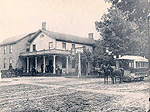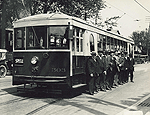In December of 1886, the Niagara Falls, Wesley Park and Clifton Tramway Company began operations over a 3.75 mile (6 km) line of track from Main Street (at Culp Street) in Drummondville to the foot of Bridge Street in the Town Of Clifton. The company began with ten (10) streetcars and forty (40) horses. The horses were used to pull the streetcars. A team of two horses were utilized for each streetcar. The streetcar and horse barns were located on Simcoe Street at Buckley Avenue. Residents in the area were always complaining of the constant noise and smell. A one-way trip took forty minutes and cost each rider 5 cents. In January of 1897, George Hanan and Ed Davis acquired ownership of the company. They speeded up the scheduled service. Hanan reduced the time for a one way trip to 30 minutes. Adult fees were 6 tickets for 25 cents and children cost 3 cents. In the summer, the railcars were open air with a conductor on board. In the winter and early spring, closed railcars were utilized. A coal stove in each car kept passengers warm during their ride. Mr. Hanan and Mr. Davis only owned the Niagara Falls, Wesley Park and Clifton Tramway Company for only three years. Other employees included: Dan Toomey, Patrick McCauthney, Joseph Lundy, John Gates, Cyrus McMicking and blacksmith, Gaius Hern. George Hanan operated the horse drawn railway from 1897 until 1900. Hanan went on to become the first mayor of the City of Niagara Falls. In 1900, they sold their company to the Niagara, St. Catharines and Toronto (Street) Railway Company. This company became known as the “NS&T”. Between April and August of 1900, the NS&T began changing the streetcar line from being horse-drawn to electricity. They also extended uninterrupted service between Niagara Falls and St. Catharines. Captain Carter was the said to have been the last passenger to ride on the horse pulled cars and the first passenger to board the electric cars. In 1906, the streetcar line was extended along Main Street to Loretto Academy at Falls View. In 1910, this line was further extended from Falls View to Stanley Avenue at the Michigan Central Railway crossing at McLeod Road. New barns for the electric streetcars were built on Fourth Avenue near the Cyanamid Company. These barns burned to the ground on December 10th 1919. They were replaced with a smaller barn and repair shop at the same location. In 1908, the Canadian Northern Railroad took control of the Niagara, St. Catharines and Toronto (Street) Railway Company (NS&T). In December of 1918, the Canadian Northern Railway assets were purchased by the Canadian National Railway. In November of 1923, the Canadian National (Electric) Railway Company operated the former NS&T streetcar lines in Niagara despite their headquarters being located in Toronto. In 1925, a new streetcar station and car barn was built on Welland Avenue in St. Catharines. Niagara Falls received eight (8) of the twelve (12) new lightweight streetcars that were manufactured in Cincinnati, Ohio. The new streetcars would ply the streets of Niagara for the next twenty (20) years.
In 1925, the streetcar line was extended from Main Street down Lundy’s Lane to Winery Road (Dorchester Road). This line was the first to be replaced by buses in May of 1947. Within the next six months, all the remaining electric streetcars would be replaced by buses. In 1927, the Canadian National Electric Railway trip between Niagara Falls and St. Catharines took 40 minutes one way. By the end of 1947, all the electric streetcars had been replaced. Between 1947 and 1950, all of the streetcars were scrapped. In 1959, Canadian National Transportation (a subsidiary of Canadian National Railway) which operated the trolley replacement bus service notified the Niagara Falls City council and the Stamford Township council that it would surrender its transportation franchise on August 31st 1960. Both councils proposed a Greater Niagara Transit Commission. Twelve new buses each capable of carrying 31 people were purchased. The original 3.75 mile route had grown to 28 miles by the time the Greater Niagara Transit Commission took over bus operations. The Canadian National Transportation (CNR) continued to operate and maintain the transit bus service until August 31st 1960, when the Greater Niagara Transit Commission took over the service with a fleet of twelve buses. The new garage site on Park Street was originally occupied by the Town of Niagara Falls electric light plant since 1891. The bus garage continue to operate here for 5 years before moving further along Park Street to the site of a former livery stable and the local Ford Motor Company which continued to occupy this site until 1946 when Canada Coach Bus Lines build a bus garage on it. This bus garage was later demolished to make way for the much newer and more modern Greater Niagara Transit headquarters and bus garage that today is located on the north side of Park Street at Erie Avenue.
Local Transportation: Since 1882, horse-drawn cars were utilized as public transportation within and between the Villages of Suspension Bridge (Bellevue) and Niagara Falls. On March 17th 1892, the Villages of Suspension Bridge (Bellevue) and Niagara Falls were amalgamated and became the City of Niagara Falls. By July of 1892, the horse-drawn cars began to be replaced by electric trolley cars. On July 15th 1892, the first run of an electric trolley car occurred along the entire length of Main Street. The new electric cable cars were capable of carrying forty people at a time while attaining a speed of up to twenty miles per hour (20 mph). Soon the trolley lines were extended to serve Buffalo Avenue to the Village of LaSalle and included lines along Sugar Street (Hyde Park Boulevard), Ontario Street, Highland Street, Pine Street, 19th Street and Niagara Street. In the latter part of 1894, the Niagara Falls, Whirlpool and Northern Railroad opened a single track rail line northward to Devil’s Hole. Both the railroad and the electric trolley service merged to become known as the International Railway Company. The Devil’s Hole rail line was extended to serve Niagara University and Riverdale Cemetery. Trolley cars were housed in car barns that were located on Main Street at the corner of Willow Street until 1901. In June of 1901, a new trolley terminal and car storage barn was opened on Riverway. On June 6th 1925, the trolley service to Sugar Street (later known as Hyde Park Boulevard) was terminated. In 1931, the service was restored to Hyde Park Boulevard but the trolley car was now replaced by a motorized bus. Motor vehicles, buses, better roads and bridges spelled the end of the trolley era. On Sunday August 22nd 1937, the last trolley streetcar in Niagara Falls made its way along Niagara Street to the Riverway Trolley Terminal.
Inter-City Transportation: In 1895, the first inter-city trolley line between the City of Niagara Falls and the City of Buffalo was built by William Ely. He was the president of the Buffalo and Niagara Falls Electric Railway. Service along this electric railway line began in 1895 utilizing existing trolley lines where possible. A trip between Niagara Falls and Buffalo took nearly two hours to complete. The line followed a route through Tonawanda, New York. The railcars traveled up to thirty miles per hour (30 mph). A round trip fare cost fifty (50) cents while a one-way fare cost thirty-five (35) cents. On June 11th 1922, the last inter-city electric trolley ran between Niagara Falls and Buffalo. It had been replaced by a much more efficient “high speed” electric railway. In 1918, a high speed electric rail line was built between the City of Niagara Falls and the City of Buffalo. The cost of building this railway exceeded $4 million dollars. This new rail service utilized new rail lines. Outside of each city the railway followed a railway along its own right of way at speeds of up to sixty miles per hour (60 mph). The sleek railcars were built of steel and were painted bright yellow. A fare from Niagara Falls to Buffalo cost sixty (60) cents including transfers from local lines as part of the fare structure. Local passengers were not allowed access to the new rail line once the train left their main terminals. In 1935, the opening of the Grand Island Bridges spelled the end of this electric railway. Motor cars and buses made the journey much more convenient and comfortable. On August 20th 1937, the last high speed electric railway car traveled between Niagara Falls and Buffalo. Both inter-city services were owned and operated the International Railway Company.
Date last updated:
February 13, 2012
THANK YOU FOR VISITING
a
history
|
||||||||||

